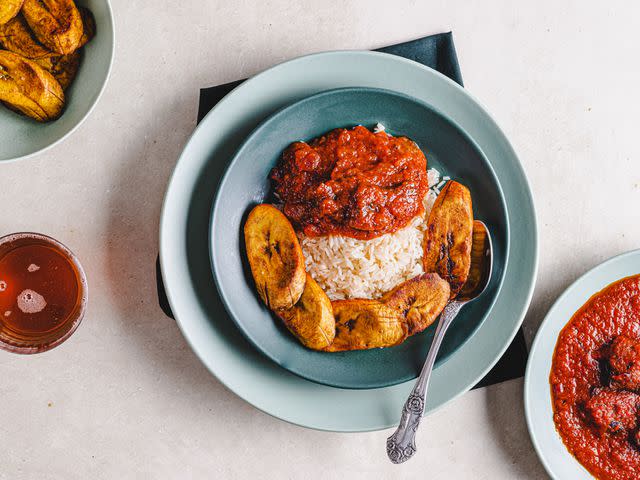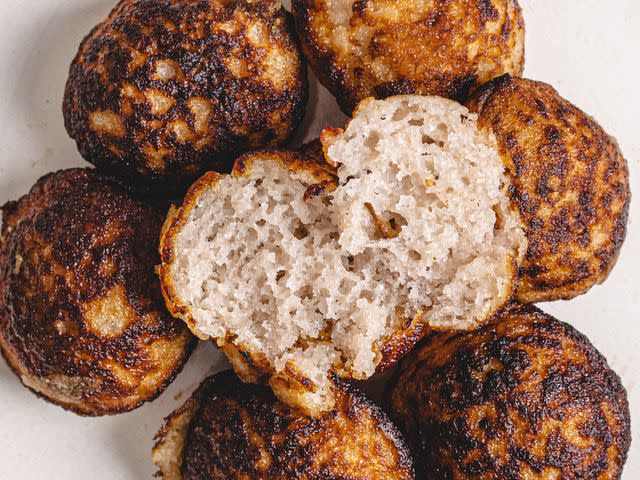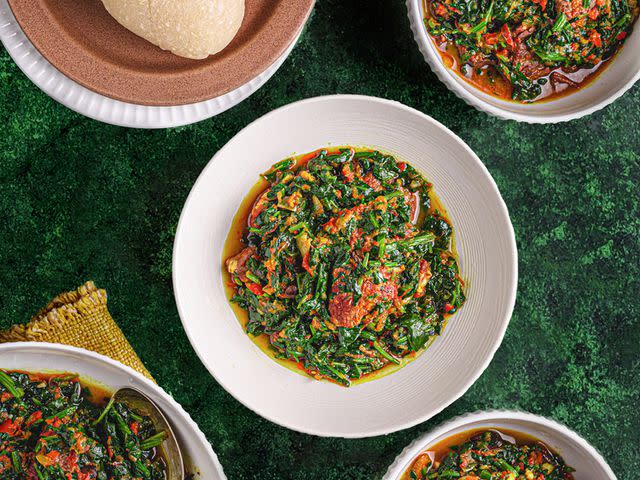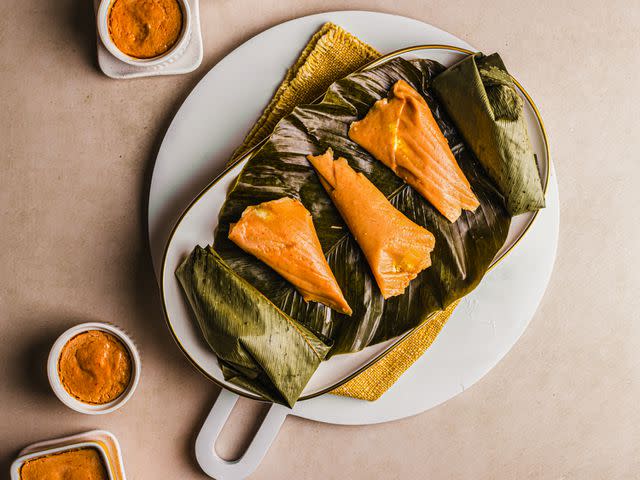Nigerian Food 101: Recipes to Get You Started
An introduction to cooking Nigerian food at home.

Serious Eats / Maureen Celestine
I grew up in Warri, on the southern coast of Nigeria, eating, drinking, and enjoying Nigerian food. While I loved our food, I hardly thought of it as worthy of celebration, and boy, did I take it for granted until it was nowhere to be found. It wasn’t until the late 1990s, when I was in my twenties at university in England, that I understood food as more than eating―not just as a means to fill my belly, but as a way to soothe my soul, connect with home, and experience a sense of belonging.
By the time I moved back home to Warri after graduation, my appreciation for Nigerian food had grown. And still, I had no idea that edible traces of Nigerian cuisine existed across the Black Atlantic, throughout the Caribbean islands and Latin America, as a result of the transatlantic slave trade.

Serious Eats / Maureen Celestine
I moved to The Netherlands for work as an exploration geologist in 2007. A few years later, in 2009, my Brazilian supervisor, Santiago, shared a story about Afro-Brazilian acarajé—a fritter that is a direct descendant of the Nigerian bean fritter known as akara. That singular conversation opened up a world of food history, heritage, legacy, and research that continues to fascinate me. It’s motivated me to unravel, unearth, and document all the ways we, as human beings, are similar—not just people of African descent, but also other cultures and cuisines where there are connections, be they geographical or based upon shared histories (e.g. Nigeria and India through British colonialism).
With that discovery, I had numerous conversations about connections through food. These conversations also had me looking inward―at home, to our cuisine―trying to understand who we, as Nigerians, are and how we eat. Broadly speaking, most of the foods we eat on a daily basis are nationally recognized dishes with regional variations. There are recipes and ingredients with clear origins from one part of the country that are part of the daily lives of Nigerians all over the country, so national seems only fitting to describe them.
Different regions have versions of the same dish. For instance, egusi soup (also known as agushi, egushi, egunsi) is beloved across the country. The differences in regional versions include how the egusi seeds are prepared: raw or toasted, dry-milled or wet-ground, light and creamy or thick with curd. The greens, herbs, and seasonings used are also unique to specific localities, but even with these different ways of preparing the soup, it's always instantly recognizable with its signature focus on the creamy, nutty flavor of the melon seed. You’ll find this true for many dishes across Nigeria—they take slightly different shape in each place while retaining their essential character.
How a Nigerian Meal Is Structured
Nigerian food culture doesn’t feature multiple courses. The main dish is usually the star of the show, and depending on the time of day, could be anything from akara or moin moin to rice, beans, and cooked vegetables with stew. A lunchtime meal at home might look like rice and stew with dodo and efo, or some combination; or it might be a soup with nuts, seeds, and vegetables served with a swallow, like eba or lafun, along with zobo or other drinks. At a party, you might begin with a plate of small chops like puff puff, then enjoy some jollof or fried rice with moin moin and dodo.
Enjoy the range our palates embrace—sweet, salty, smoky, umami, spicy, and everything in between.
For ease, I’ve grouped the recipes here into fritters and fried doughs; swallows; soups, stews, and sauces; rice; cooked vegetables; snacks; and drinks. They capture the framework of our cuisine, and the majority of the 200-plus million people in Nigeria would recognize most of them in one form or another. Fresh fruit and vegetables, in abundance all year round, are also the go-to for people wanting a sweet bite.

Serious Eats / Maureen Celestine
I must say though, these recipes are just a handful of the hundreds of Nigerian dishes that exist and are living and thriving across the country. Still, they give you some insight into what Nigerians eat; when, where, and how; from north to south and east to west. Enjoy the range our palates embrace—sweet, salty, smoky, umami, spicy, and everything in between.
Fritters and Fried Doughs
Fried foods are extremely popular across Nigeria, for both meals and snacks. Made from fresh and fermented batters and doughs, you'll find them on the streets or at home. However, not all fried foods are of the deep-fried variety. In the shallow-fried foods category, there's masa, crunchy fermented rice cakes cooked in a special pan called a kasko; they can also be made with corn, wheat, semolina, and other cereals.

Serious Eats / Maureen Celestine
Puff puff is one of many deep-fried, golden brown Nigerian treats. There are also buns leavened with baking powder instead of yeast, and several types of rolls, from fish to egg rolls—similar to Scotch eggs in that the boiled eggs are dough-wrapped and deep-fried. And of course, there’s akara, made from beans, which is as much a Saturday morning home breakfast as it is a street classic everyday of the week.
Swallows
Swallows are daily essentials for many Nigerians. They are soft, cooked doughs, not designed to be eaten on their own but instead paired with soups and stews. Swallows can be made with a single ingredient or a series of ingredients combined, like cereals, roots, tubers, and vegetables.
Swallows are made in two different ways: The first is by boiling, then working the cooked ingredient(s) into a soft, sticky dough (think mashed potatoes but stickier and stretchier, though only those made with tapioca starch have that mochi-like stretch); the second is by cooking fine and coarse flours or meals in water into cohesive doughs, much like polenta or mashed potatoes without butter or seasoning. In the north of Nigeria, cereals like rice, millet, Guinea corn (sorghum), and corn are the most common ingredients in swallows; in the south, east, and west, swallows tend to be made from root crops and vegetables like yams, plantains, sweet potatoes, and breadfruit.

Serious Eats / Maureen Celestine
Eba and lafun are two swallows made from cassava meal. Despite having this ingredient in common, they are completely dissimilar, both in appearance and taste, due to their differences in processing. While eba has a touch of grit, lafun is super smooth, thanks to the gelatinized quality of its pure starches. With the exception of eba imoyo—a specialty of the Eko people of Lagos—which is cooked in a seafood stock, most swallows are cooked in water, and are neither sweetened nor salted so that the flavor of the ingredient shines through.
Soups, Stews, and Sauces
Soups, stews, and sauces are the mainstay of Nigerian cuisine, from light drinking broths like pepper soup to thick stews (which we call soups in Nigeria) like egusi and efo-riro and stew, a specific red dish commonly made with a puréed base of tomatoes, onions, and peppers, of which there are many variations, including obe ata. With a pot of stew or soup, there are so many possibilities, and you could put a meal together fairly quickly. Sauces are a mix of meat curries—similar to Japanese or Korean curries—to ofada sauce, an Indigenous red sauce with bite-sized pieces of meat, lots of iru (fermented seeds), and a sweet-hot pepper base.

Serious Eats / Maureen Celestine
Most soups and stews typically begin with a seasoned stock and a variety of plant, seafood, and animal proteins. This seasoned base is thickened with ground leafy vegetables, legumes, gums, nuts, and seeds. Soups tend to be flavored with unrefined red palm oil; fish powder or dried and ground crayfish; and stock cubes for umami, which altogether deliver complex flavors. Traditional stews are typically made with a red tomato-pepper base, but can also be made in a similar fashion to soups, or with dried thyme, vegetable oil, and a British colonial-era seasoning like curry powder.
These are eaten with a variety of dishes—rice, bread, or swallows, and cooked vegetables like yams, plantains, or sweet potatoes that are boiled, grilled, roasted, or fried. Stew can be a dip for fried foods, or more liberally spooned over rice and beans. Soups can be eaten on their own or paired with swallows. Eba and egusi are personal favorites, as is lafun with both efo and obe ata.
Rice
You’ll find rice everywhere in Nigerian cuisine—at home, as street food, and at parties and celebrations. Most rice dishes can be paired with an assortment of sides, from white rice and stew with beans to dodo and jollof rice, or fried rice with moin moin and coleslaw. Jollof rice and Nigerian fried rice dishes are particularly saved for special occasions.
Nigerians love rice—long-grain rice especially. And here, it isn’t a side dish. Instead, it's the main: aromatic varieties similar to Thai Jasmine are used in swallows, and converted or parboiled rice is served with stew or soups or used to make jollof and Nigerian fried rice.

Serious Eats / Maureen Celestine
My favorite types of rice are the indigenous, red-streaked varieties of oryza glaberrima, especially those from Abakaliki (east), and Ekpoma (south). I love them for their sweet flavor and fragrance when the rice is simply boiled, but also when it’s made into coconut rice (with fresh, homemade coconut milk)—that’s a top-10 in my taste memory. There’s also ofada rice, which is fermented and processed rice that fills the air with the most blue-cheesy pungence during the cooking process, none of which interferes with the beautiful, complex, sweet flavors on the plate and the palate. It’s served with ofada sauce.
Cooked Vegetables and Legumes
There are so many vegetables that take the form of a main or side. They are boiled, fried, roasted, cooked into thick stews, and more, from plantains used at all stages (green and unripe to yellow-black and ripe, and even over-ripe) to yams, taro, and both regular and sweet potatoes. Fried plantains, known as dodo, are always a crowd pleaser, as are fried yams. Set aside some stew to dip it in, plus some fried eggs to the side, and you have a quick and satisfying meal.

Serious Eats / Maureen Celestine
Legumes are simply cooked and stewed, but also made into wraps, similar to tamales. Beans are often soaked, skinned, and pureed for dishes like akara, but are also scooped into ramekins or wrapped in broad leaves.
Snacks
There are a myriad of snacks, from fresh fruit and vegetables—coconuts, corn, carrots, and cucumber are popular snacks next to meaty dishes like suya—to meat pies, which are parcels of dough filled with seasoned minced meat and baked to perfection; and chin chin, a snack of tiny cookie-cracker-crunchy bites, made from deep-fried, seasoned dough, and enjoyed by the handful all year round, but especially at Christmas.
Drinks
Nigerians serve a host of both hot and cold drinks. There’s zobo (which you might already be acquainted with as hibiscus tea), soft drinks, non-alcoholic malt drinks, alcoholic beers and spirits, bitters, shandies, palm wine, and kunu, a variety of milky beverages made from tubers and cereals.

